
Flies are insects of the order Diptera, the name being derived from the Greek δι- di- "two", and πτερόν pteron "wing". Insects of this order use only a single pair of wings to fly, the hindwings having evolved into advanced mechanosensory organs known as halteres, which act as high-speed sensors of rotational movement and allow dipterans to perform advanced aerobatics. Diptera is a large order containing an estimated 1,000,000 species including horse-flies, crane flies, hoverflies and others, although only about 125,000 species have been described.

Crane fly is a common name referring to any member of the insect family Tipulidae. Cylindrotominae, Limoniinae, and Pediciinae have been ranked as subfamilies of Tipulidae by most authors, though occasionally elevated to family rank. In the most recent classifications, only Pediciidae is now ranked as a separate family, due to considerations of paraphyly. In colloquial speech, crane flies are sometimes known as "mosquito hawks", "skeeter-eater", or "daddy longlegs",. The larvae of crane flies are known commonly as leatherjackets.

Horse-flies or horseflies are true flies in the family Tabanidae in the insect order Diptera. They are often large and agile in flight, and the females bite animals, including humans, to obtain blood. They prefer to fly in sunlight, avoiding dark and shady areas, and are inactive at night. They are found all over the world except for some islands and the polar regions. Both horse-flies and botflies (Oestridae) are sometimes referred to as gadflies.
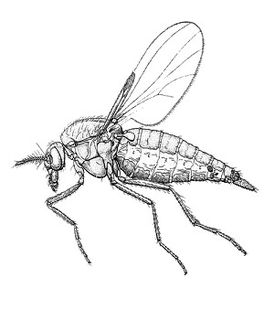
Leptoconops torrens is a species of small biting flies in the no-see-um family Ceratopogonidae. They were first mentioned in writing by Charles Henry Tyler Townsend in 1893. The name Leptoconops carteri is a junior synonym of L. torrens. They are prevalent in the southwestern and southeastern areas of the United States. In early stages of life, L. torrens flies dwell in soil, then emerge to feed and breed as fully developed adults.

The Asilidae are the robber fly family, also called assassin flies. They are powerfully built, bristly flies with a short, stout proboscis enclosing the sharp, sucking hypopharynx. The name "robber flies" reflects their notoriously aggressive predatory habits; they feed mainly or exclusively on other insects and, as a rule, they wait in ambush and catch their prey in flight.
The Nymphomyiidae are a family of tiny (2 mm) slender, delicate flies (Diptera). Larvae are found among aquatic mosses in small, rapid streams in northern regions of the world, including northeastern North America, Japan, the Himalayas, and eastern Russia. Around a dozen extant species are known, with two fossil species found in amber, extending back to the Mid Cretaceous. Under an alternative classification, they are considered the only living representatives of a separate, suborder called Archidiptera which includes several Triassic fossil members. The family has characteristics associated with the Nematocera as well as the Brachycera. The antennae are shortened as in the Brachycera and these flies are long, having a snout with vestigeal mouthparts, non-differentiated abdominal segments with large cerci. The wings are narrow and hair-fringed and have very weak venation. They are known to form cloud-like swarms in summer and the short-lived non-feeding adults have wings that fracture at the base shortly after mating.
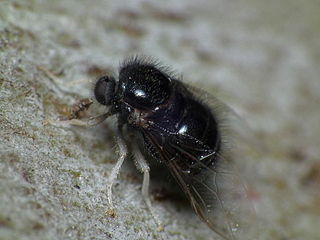
The Acroceridae are a small family of odd-looking flies. They have a hump-backed appearance with a strikingly small head, generally with a long proboscis for accessing nectar. They are rare and not widely known. The most frequently applied common names are small-headed flies or hunch-back flies. Many are bee or wasp mimics. Because they are parasitoids of spiders, they also are sometimes known as spider flies.

The Therevidae are a family of flies of the superfamily Asiloidea commonly known as stiletto flies. The family contains about 1,600 described species worldwide, most diverse in arid and semiarid regions with sandy soils. The larvae are predators of insect larvae in soil.

The Brachyceran family Vermileonidae is a small family of uncertain affinities and unusual biology. It includes fewer than 80 described species, most of them rare and with restricted distribution, in 10 genera. Historically the vermileonids had been regarded as belonging to the family Rhagionidae, possibly in a subfamily Vermileoninae. Their biology and morphology are so markedly distinct from the main Rhagionidae sensu stricto however, that the placement as a separate family has been widely accepted.

Rhagionidae or snipe flies are a small family of flies. They got their name from the similarity of their often prominent proboscis that looks like the beak of a snipe.

Tabanus maculicornis also known as the narrow-winged horsefly is a species of biting horse-fly.
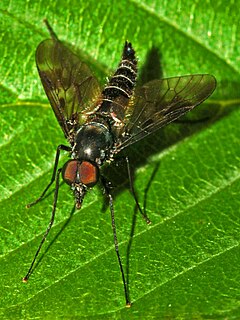
Athericidae is a small family of flies known as water snipe flies or ibis flies. They used to be placed in the family Rhagionidae, but were removed by Stuckenberg in 1973. They are now known to be more closely related to Tabanidae. Species of Athericidae are found worldwide.
Austroleptis is a genus of snipe flies, and the sole genus in the family Austroleptidae; until 2010, it was placed in the family Rhagionidae. They are small to moderately sized flies of around 3 to 7.7 mm.

Pelecorhynchidae is a small family of flies. All of the genera were originally placed in the family Rhagionidae, and their elevation to family rank has been controversial. Other phylogenetic analyses have supported Pelecorhynchidae as a distinct clade from Rhagionidae. The adults of Pelecorhynchus mostly feed on nectar of Leptospermum flowers. Larvae have been collected in the damp margins of swamp areas, where they feed on earthworms.

Haematopota pluvialis, the common horse fly or notch-horned cleg fly, or simply cleg in Scotland and northern parts of Ireland, is a species belonging to the family Tabanidae subfamily Tabaninae.
Diptera is an order of winged insects commonly known as flies. Diptera, which are one of the most successful groups of organisms on Earth, are very diverse biologically. None are truly marine but they occupy virtually every terrestrial niche. Many have co-evolved in association with plants and animals. The Diptera are a very significant group in the decomposition and degeneration of plant and animal matter, are instrumental in the breakdown and release of nutrients back into the soil, and whose larvae supplement the diet of higher agrarian organisms. They are also an important component in food chains.

Chrysops caecutiens, common name splayed deer fly, is a species of horse fly belonging to the family Tabanidae. It is also known by the colloquial name Scotch Cleg.
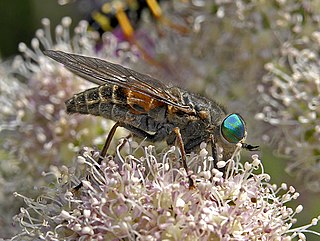
Hybomitra montana, the slender-horned horsefly, is a species of horse flies in the family Tabanidae.
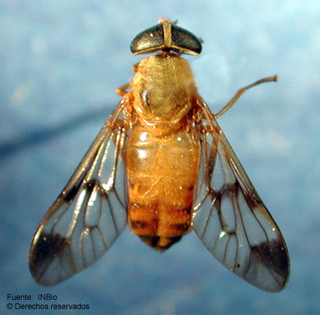
Diachlorus ferrugatus, commonly known as the yellow fly in the United States or doctor fly in Belize, is a species of highly aggressive biting horse-fly of the family Tabanidae native to North and Central America to Costa Rica.
Mallophora ruficauda is a species of parasitic robber fly in the family Asilidae, endemic to South and Central America. Like other robber flies, M. rauficauda is known for its aggressive behavior and predation upon other insects, especially bees. M. ruficauda mimics a bumblebee to fool predators into thinking it has a painful sting and is not worth eating.
















